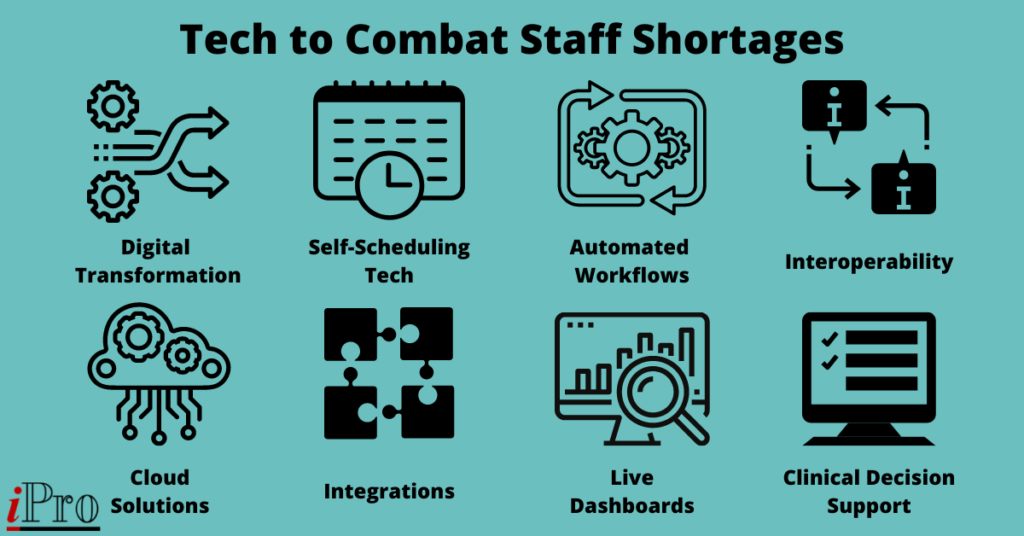(Last updated 3/4/2022)
Healthcare staff shortages are a serious problem, with healthcare providers scrambling to find solutions to stem the outflow of employees. In fact, October 2021 was dubbed “Striketober” on social media as masses of healthcare workers either quit, went on strike, or prepared to do either after spending nearly two years on the frontlines of the COVID-19 pandemic. Top demands from those choosing to strike include:
- Pay increases
- Meal and rest breaks
- Better benefits
- Shorter shifts
In a recent blog, we featured provider burnout and staff turnover as one of healthcare’s biggest fears. Some healthcare leaders have even said staff shortages are a bigger issue than unvaccinated workers. A key weapon in the fight against burnout and turnover is technology. Digital technology is so important to combating staff shortages that the UK has granted its National Health Service with nearly £6 billion in extra funding for tech initiatives to tackle the healthcare staffing crisis. UK Chancellor Rishi Sunak called the funding “game changing.” In this blog, we’ll dive deeper into the issue and focus on eight ways healthcare leaders can incorporate technology to combat staff shortages.
1. Digital Transformation to Improve Efficiency
The number one way to leverage tech to combat staff shortages is an overall commitment to digital transformation. It’s often said that healthcare lags other industries in terms of innovation and technology by a decade or two. Digital transformation can not only improve the patient experience, but it can also reduce employee workloads and labor costs by improving efficiency. The rest of our list focuses on specific types of digital transformation and how they can combat healthcare staff shortages.
2. Self-Scheduling and Preparation Tech to Empower Patients
One way to reduce staff workloads is to empower patients with the tools they need to manage their own healthcare experience. Two elements of the care process that can easily be managed by patients are scheduling and preparation. As healthcare becomes more of a consumer market, self-scheduling tech is an important component of the digital front door. Shifting this task to patients not only helps them feel more in control of their health journey, but it also allows staff to focus on other tasks or enjoy some downtime. Similarly, providing patients with procedure-specific preparation instructions, such as video links or PDF’s can reduce the time staff spends answering questions.
For more tips to schedule more patients and optimize revenue, download this handy infographic.
3. Automated Workflows to Mitigate Burnout
Another tactic to reduce workloads and mitigate burnout is to automate workflows. In MedScape’s 2021 Physician Suicide and Burnout report, “too many bureaucratic tasks” was the number one contributor to burnout according to 58% of healthcare workers. Many daily tasks, such as data entry and reporting, can be automated. This frees up staff to focus on other tasks that can’t be automated. Automating these often mundane tasks can also mitigate burnout by breaking up the monotony of performing the same task over and over. A 2018 Deloitte survey found that robotic process automation (RPA) can account for an average of 20% full-time equivalent (FTE) capacity. The survey also found automating processes can lead to improved accuracy, compliance, productivity, and cost reduction.
For more tips on implementing automation, check out this Healthcare IT News article on robotic process automation.
4. Interoperability to Improve Patient Outcomes & Efficiency
Utilizing technology to combat burnout and turnover works best when the platforms you use are interoperable with each other. Interoperability is key in this digital age. It ensures better patient outcomes, more efficient workflows, and minimal errors by making information available to providers instantly. Interoperable platforms also eliminate unnecessary paperwork, such as faxes, which eases HIPAA and security concerns and eliminates the misplacement of important documents. Interoperability can relieve employee stress by making it easy to find important information and bringing peace of mind that patients are safe and satisfied.
5. Cloud-based Solutions for Better Collaboration and Lessened IT Burdens
Frontline workers aren’t the only ones to consider when combating staff shortages. IT personnel can also experience burnout, especially during periods of high patient inflows when keeping systems up and running is more crucial than ever. Utilizing cloud-based software can ease IT burdens by requiring less on-site data storage, providing access to built-in troubleshooting tools, and offering immediate access to 24/7 vendor support, increasing cybersecurity, and improving collaboration. Cloud-based solutions can also be accessed remotely so IT staff can still perform crucial tasks even when they can’t physically be in the office, whether due to inclement weather, caring for a family member at home, or the pandemic. Frontline staff also benefit from cloud utilization due to the peace of mind of not having to worry about downtime, data breaches, and where their data comes from.
6. Integrations and Scalability to Unify Cross-Departmental Goals
Ensuring technology is scalable and able to integrate with other solutions helps the organization achieve its cross-departmental goals. Integrations help streamline workflows and improve collaboration. When different solutions don’t integrate with each other, it can lead to duplicate entry, increased errors, and burned out staff. Similarly, if solutions aren’t able to scale to meet the needs of a growing organization, it can slow down operations and lead to frustration. When solutions are both scalable and able to integrate with other solutions, the organization runs much smoother, leading to satisfied patients and staff.
7. Live Dashboards to Make Improvements
Live reporting dashboards can combat staff shortages by leading to a host of operational and productivity improvements. For instance, live dashboards can help monitor room utilization, peak capacity and inflow times, and provider throughput. Analyzing this data in real-time can help management determine where and when staff may be overworked. Relieving overworked, overstressed staff can go a long way to combating healthcare staff shortages.
8. Clinical Decision Support Mechanisms to Shorten Throughput
Another piece of technology that can combat staff shortages is clinical decision support, or qCDSM. A qCDSM ensures ambulatory order accuracy by requiring a series of questions to be answered before an order is submitted. This minimizes ICD-10/CPT code mismatches, resulting in maximized reimbursements. Accurate orders also shorten throughput by ensuring the right order is entered for the right patient, eliminating the need to reschedule or delay procedures due to inaccurate orders.
Fighting Staff Shortages Together

Combating healthcare staff shortages is no small task. Healthcare workers are leaving the field for a variety of reasons, though most of them all come down to one thing: burnout. Some healthcare organizations are offering financial incentives ranging from higher salaries to bonuses in the hopes of retaining and attracting staff. While this may stem the turnover tide in the short term, it doesn’t address the root of the problem. As such, burned out workers may still decide to leave several months down the road even after a pay increase.
That’s why healthcare leaders should utilize technology to combat staff shortages. To recap the eight tech-driven tactics to fight burnout we discussed in this blog:
- Digital transformation to improve efficiency
- Self-scheduling and preparation tech to empower patients
- Automated workflows to mitigate burnout
- Interoperability to improve patient outcomes and efficiency
- Cloud-based solutions for better collaboration and lessened IT burdens
- Integrations and scalability to unify cross-departmental goals
- Live dashboards to make improvements
- Clinical decision support mechanisms to improve accuracy and shorten throughput
At iPro, our ambulatory order management solution, iOrder, includes a variety of features that can help you fight burnout and turnover. These features include:
- Integrated clinical decision support mechanism (qCDSM) for order validation and PAMA compliance
- Links to procedure-specific preparation instructions for patients
- Electronically generated orders that provide complete transparency, reduce back-and-forth calls, and eliminate faxes
- Live reporting dashboards to monitor real-time data
- Cloud-based storage with 24/7 customer support
To learn more about how iOrder can help combat staff shortages and improve your ambulatory department, contact us today.




